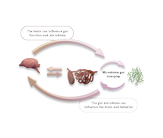

Unlocking the secrets of the microbiome could provide the key for a longer, healthier life.
The role of the intestinal tract goes far beyond digestion. While the gastrointestinal tract (also called the gut) is the center of food digestion and nutrient absorption, it also plays a key role in pets’ overall health. It houses the enteric nervous system, or ‘second brain’, and plays a vital role in modulating the body’s immune system.1
The gut is home to trillions of microorganisms – the microbiota. The gut microbiome is comprised of all of these organisms and their genetic material (DNA and RNA). Analysis of the genetic material is how most recent studies identify the microbiota, but the terms microbiome and microbiota are often used interchangeably except in scientific research.2
Gut bacteria have many different functions in maintaining pet health. They also form a crucial part of the bidirectional interaction between gut and brain known as the gut-brain axis,3 and there is growing evidence that the microbiome impacts the health of other organs such as the skin, heart and kidneys.
Dysbiosis, an imbalance in beneficial vs potentially harmful microorganisms, is correlated with a number of disease states – including obesity.1
While there are numerous influences on gut microbiota composition, diet is considered among the most crucial.2 Purina’s ongoing research into nutritional strategies that improve the gut health of pets, and the balance between beneficial bacteria and pathogenic bacteria, includes probiotics, prebiotics, non-replicating microorganisms (NRMs) and bovine colostrum, among others.
A better understanding of the microbiome’s impact on pet health can help pets live longer, healthier lives.
Explore areas of gastrointestinal health:
Find out more
- Blake, A. B. & Suchodolski, J. S. (2016). Importance of gut microbiota for the health and disease of dogs and cats. Animal Frontiers, 6(3), 37—42. doi: 10.2527/af.2016-0032
- Marchesi, J. R., & Ravel, J. (2015). The vocabulary of Microbiome research: a proposal. Microbiome, 3, 31. doi: 10.1186/s40168-015-0094-5
- Oriach, C. S., Robertson, R. C., Stanton, C., Cryan, J. F., & Dinan, T. G. (2016). Food for thought: The role of nutrition in the microbiota-gut-brain axis. Clinical Nutrition Experimental, 6, 25–38.




